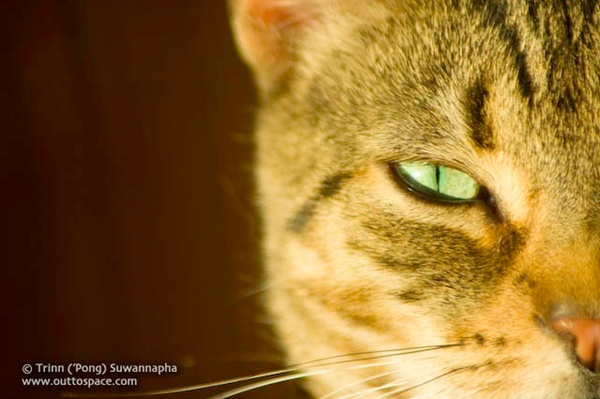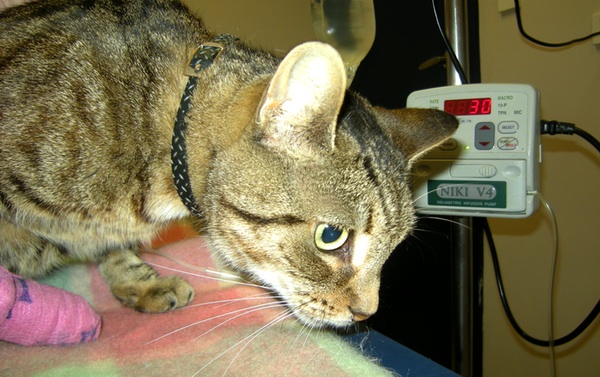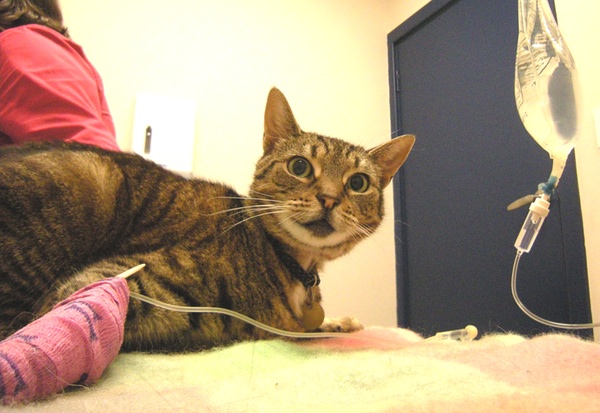I have just published a full accounting of the Artemis Medical Fund. Thank you so much for your generosity. In summary, your donations covered all costs, and the remainder was almost the same as the total from people who told me to keep the remaining funds myself. There was a small difference, a little over $50, so I’ve made a $100 donation to the Cat Protection Society of NSW through their online donation page at Everyday Hero.
Goodbye, Artemis
Artemis breathed her last breath at 12.37pm AEDT today. It was a peaceful moment. I held her while she moved from this world into the next. I cried. I am crying now.
Artemis led a gloriously adventurous life, if perhaps short at a little over seven years. She hunted everything from moths and grasshoppers to rats and noisy miner birds, eating most of them. She even brought us the striped marsh frog from the garden pond — three times before she learned, the hard way, that it’s poisonous. She never did catch a currawong, and I’m glad of that.
Artemis used up one of her nine lives when her tail was crushed and eventually amputated.
Today I chose to take her ninth.
Artemis, it’s decision time…
Thanks to today’s X-rays and ultrasound, we have some answers. Sadly for Artemis, the answers are not good. Not good at all.
Artermis’ left kidney is quite small, only 2.8cm long. A normal cat kidney might be 3.5 to 4.5cm. Perhaps she was born with it small, perhaps it’s been damaged later. Kidneys do shrink with some chronic problems. But either way, it’s clearly dodgy.
The right kidney is bigger, but there’s a kidney stone. It’s only 1.5mm in diameter, but we’re talking about a cat not a human. That stone is currently blocking the urethra, and perhaps a back-up of urine is inflating that kidney. It’s possible the stone has only just moved there, which could explain the reversal of Artemis’ blood results over the past few days.
“I would have thought she wouldn’t have recovered as well as she did initially with that stone there,” Dr Emily Payne at Pet Vets told me this afternoon.
Now if this were simply a kidney stone, we’d just operate and remove it. “If it was just that one kidney, the prognosis wouldn’t be too bad,” Dr Payne said. But with the other kidney clearly not right? “The outlook isn’t that great.”
Since so many people now have a stake in Artemis’ future, I’ll present the options and ask for your advice.
Artemis’ kidneys are not responding
Well that’s not good. With intravenous fluids reduced to 1.5x maintenance levels for two days, Artemis’ blood test results headed in the wrong direction. We now need to discover if there’s some reason for the kidneys not working other than, well, failed kidneys.
Dr Meredith Gibbs from Pet Vets phoned through the results a short time ago. Compared with the positive signs 48 hours ago, it’s “disappointing”.
Creatin levels climbed back to 690. Urea was back up to 22.7, although that’s not the worst it’s been. Red blood cell count is still low, in the mid-20s instead of the 30+ it should be in a cat — although that’s possibly just a symptom of the high fluid levels. Electrolytes are still a bit whacky.
So Artemis goes back on the 2x maintenance levels of intravenous fluids — the poor man’s dialysis — until we figure out what’s going on.
And yet, Artemis has reportedly been “even more feisty” than she was on Sunday. She’s been eating overnight, she’s interacting with staff, and she’s showing all the signs of simply being frustrated with having to be in a cage.
After consultations with a specialist at the University of Sydney, a plan has been agreed upon. Ultrasound, X-rays and attempts to culture potential infectious agents to see if there’s some treatable cause of the kidneys not working. That’ll begin tomorrow and we’ll have news of the ultrasound and X-rays around 24 hours from now.
If none of those procedures reveal anything treatable, then we’re looking at untreatable kidney failure. It may not be that. But it’s a distinct possibility, despite Artemis’ apparent external health.
As for exploring the options, there is a veterinary surgeon in Melbourne who does kidney transplants. Enquiries have been made, and we’ll see what the requirements are, but… you know… We’ll see.
Artemis’ promising blood results
Artemis’ latest blood results have just been phoned through. Creatin has continued to drop, from 416 to 376, slowly moving towards the normal maximum of 212. Urea is down from 36 to 19.5, again moving steadily towards the target 12.9. Phosphorus and calcium have stabilised. Her red blood cell count is low, but that’s possibly just because she’s on such a high rate of fluids.
The decision has been made to reduce the flow of intravenous fluids down to 1.5x maintenance levels, rather than the 2x she’s been on, and see what happens over the next 48 hours. For the background to that, see the post from earlier today.
“We’re looking at the possibility we could get [her] through it,” says Dr Meredith Gibbs.
Artemis improves, but it’s early days yet
I’ve just spent half an hour with Artemis, and here’s a picture. While she’s showing marked improvement, she’s still on fluids at twice the normal maintenance level to flush out any toxins — think of it as poor man’s dialysis — and it’ll still be some days yet before we really know what’s going on.
First the good news. Artemis has been eating. While she was obviously annoyed at still being connected to the drip, she was exhibiting her normal behaviours. I’m friendly, but don’t touch me. Yes, I want attention, but don’t pick me up. How can I escape from this table? How can I get my leg out of this uncomfortable bandage? This is a great sign.
However she needs to stay in this stable state without being on intravenous fluids.
As I mentioned earlier, the blood tests done on Friday afternoon showed that the enzymes associated with kidney problems had been declining, although they were still way above normal levels. Urea levels, for example, had dropped from 113 during the crisis night to 36, but they should be below 12.9. Creatin levels were at 416 on Friday, when they should be below 212. On crisis night they were so high that the measurement technique didn’t even work, even with the blood sample being diluted.
Curiously, certain blood tests showed indications of acute kidney problems, but others were associated with chronic problems.
In brief, as I discussed with Dr Meredith Gibbs today, Artemis was so profoundly ill — so near death! — that everything was very different from normal. We shouldn’t read too much into any of this, but simply take everything one step at a time.
And the next step is further blood tests this afternoon, 48 hours after the last batch. If all these enzyme levels are returning to normal, then the intravenous fluids will be reduced slowly to see what happens — to see whether Artemis’ kidneys can now sustain their function or not. If the blood tests are not showing sufficient movement towards normal today, well, she stays on the high-level fluids for another 48 hours. And then we try again.
So what’s the longer-term view?
Continue reading “Artemis improves, but it’s early days yet”



